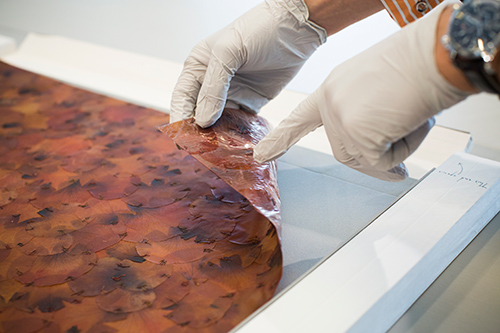Artist Mel Bochner visited the Harvard Art Museums last October to deliver a lecture about his work. But that wasn’t all he did during his time here. Besides meeting privately with students, Bochner was the subject of an interview, conducted by Penley Knipe, the Philip and Lynn Straus Senior Conservator of Works of Art on Paper and head of the paper lab.
With all of Bochner’s work from the museums’ collections spread out in the Art Study Center, Knipe and Bochner spoke for about an hour. Knipe asked questions about everything from Bochner’s paper preferences, to his thoughts on the aging of his art, to how he wants to see his works framed—the sorts of topics he said that don’t usually get discussed. These subjects are essential to conservators, however.
“Mel is very involved with all the steps of making, and we both really enjoyed talking in depth in front of the artwork,” Knipe said afterward. “He was really pleased with the breadth of the works by him that we have in our collections, and he was especially touched that the Harvard Art Museums care so much about the works and how they were made.”
The private artist interview is a regular practice at the museums, with conservators recording their conversations with living artists (and artists’ associates) whose works are in our collections. In recent years, interviews have been conducted with Leonardo Drew, Rachel Harrison, Jesse Aron Green, Carlos Amorales, and Rebecca Horn, among others. The recordings are later saved in the files for individual objects and are accessible only to conservators, museums staff, and established scholars with specific research interests.
“We conduct artist interviews because we believe it’s important to be fully informed about what it takes to own a work of art,” said Angela Chang, assistant director of the Straus Center and conservator of objects and sculpture.
Earnest Discussions
Recent conversations with artists have focused on the creative process for specific objects. “It’s a way of getting firsthand information and recollections from the artists,” said Narayan Khandekar, director of the Straus Center and senior conservation scientist. “Making a work of art involves a whole series of decision making and problem solving, and when we talk to artists, we can better understand that process.” Particularly as objects age or display conditions or environments change, materials or components may need to be replaced (as is sometimes the case in works of time-based media); the insights gained from these interviews can assist conservators, curators, and others in knowing how best to care for and treat a piece when this time comes.
Though conservators come to the interviews prepared with questions, they seek to engage in genuine conversations with the artists. The technique requires both parties to be open and straightforward.
“To have a good conversation, they have to trust you and you have to trust them,” Khandekar said. “You have to be willing to be vulnerable yourself and to ask questions. And you have to be genuinely curious about the work that they’re making.”
Khandekar and Chang interviewed Doris Salcedo last November, just a few days before the opening of the special exhibition Doris Salcedo: The Materiality of Mourning, about her work A Flor de Piel (2013). Made of hand-sewn red rose petals permanently suspended in a state between life and death, the sculpture presents one-of-a-kind challenges for current and future conservators.
“It was a wonderful conversation,” Khandekar said. “It was a chance to talk to the artist in a very detailed way about all kinds of questions that we’ve had about this work. Questions like, does she see it as one work or multiple works [because she added extra sheets of petals to the original version during the exhibition installation]? It was also great to see her be so warm and so funny—she’s got a great sense of humor.”
The fact-finding can go both ways, too. In many cases, Khandekar said, artists end up asking conservators questions. Topics have included issues that the artists are tackling and materials that conservators recommend. Occasionally, conservators have been invited to follow up with future meetings. After Knipe’s interview with Bochner, for instance, she said she hoped to visit New York to see Bochner make his sculptural prints with a hydraulic press.
In some cases, conservators also interview assistants and studio associates, many of whom have spent decades working closely with their artist-managers. “We often ask them about the nuts and bolts, such as how they execute concepts,” Chang said.
Reference Material
After each interview, the (audio or video) recordings are edited and transcribed, added to the object file, and relevant staff members are informed about any pertinent or new information about the object that was discussed.
Though the interviews occur just occasionally, depending on when artists visit, they are experiences the conservators value highly. Indeed, Chang said, “they’ve been a really gratifying aspect of my job.” In fact, they are critical: using firsthand information to shed light on works is “part of our responsibility as stewards of the art,” she said.




